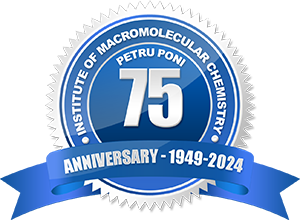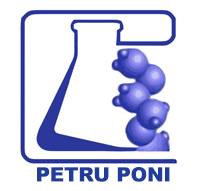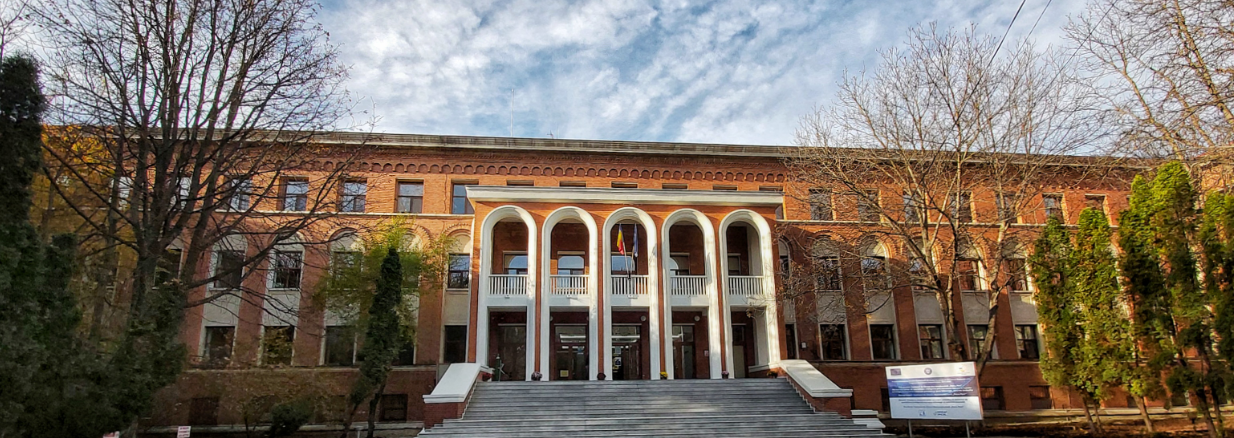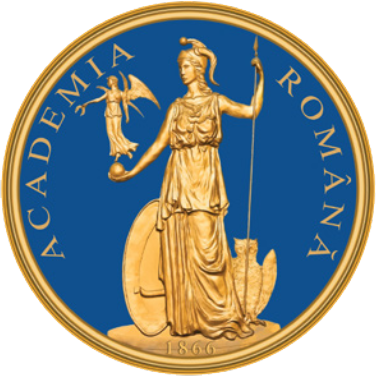|
|
 | Laboratory 4. Functional Polymers |
| Head of laboratory: Dr. Marcela MIHAI |
|
|
| Project: Development of photosensitized nanoparticles-hydrogel composites with catalytic properties for environmental applications |
Project: PN-IV-P2-2.1-TE-2023-2005
Acronym: PhotoActComp
Project Leader: Dr. Nicusor FIFERE
Duration: 2025 – 2026
To meet the challenges of extensive agriculture, a wide range of pesticides is currently applied, many of them irrationally, especially in developing countries. Their spread in the environment led to the pollution of surface and ground water over time. This forced the international community to look for new effective measures to neutralize these ‘contaminants of emerging concern’. The current project proposes the neutralization of pesticides through photochemical degradation, using sensitized recoverable photocatalysts and solar energy. Modern techniques based on ZnO nanoparticles sensitized with photosensitive organic compounds, which activate the nanoparticles by irradiation in the visible light range, are envisaged. To enhance the efficiency and recoverability of the sensitized photocatalyst, its incorporation into a porous environmentally friendly hydrogel matrix will be explored. Thus, the sorption of pesticide formulations would be facilitated within the pores of the hydrogel matrix, at the level of the photocatalyst, enhancing thus the photodecomposition reactions. The synergy of processes that give functionality in the visible spectral range of light with the reuse ability is expected to bring the photocatalytic composites among the best performing pesticide neutralization technologies.
https://icmpp.ro/projects/l4/about.php?id=176 |
|
| Project: Harnessing the multifunctionality of tailor-made polysaccharides to design nanostructured sorbents for wastewater treatment |
Project: PN-IV-P1-PCE-2023-1968
Acronym: MPSorb
Project Leader: Dr. Maria Valentina DINU
Duration: 2025 – 2027
Significant progress has been made in polymer science through collaborative efforts across different areas of chemistry. Emerging from combination of polymer materials with chemical transformations, a more efficient approach has been envisioned as promising alternative in synthesis of polymer architectures with multiple functions. Thus, tailor-made multifunctional polymer sorbents (MPSorbs) can be obtained in fewer synthesis steps by simultaneously combining two or more starting materials in a "one-pot" reaction. In this project, the “one-pot” concept is proposed to modify polysaccharides and develop nanostructured MPSorbs through self-assembly and cross-linking. The successful introduction of hydrophobic functional groups will allow the sorbents to effectively remove organic contaminants including oils, hydrophobic drugs, and/or complex pesticide formulations. At the same time, the non-modified hydrophilic moieties of polysaccharides will favor the adsorption of soluble pollutants, such as metal ions. Furthermore, the antimicrobial and antioxidant potential will be explored by introduction of natural active compounds (monoterpenes and/or phenolic acids) in synthesis of polysaccharide derivatives. The synergy between multiple functionalities is expected to pave the way for more efficient sorption systems that will lower the amount of material required to remove various contaminants, and thus reduce the production costs without compromising the adsorption features.
https://icmpp.ro/projects/l4/about.php?id=175 |
|
| Project: Anthocyanins entrapped in polysaccharide-based materials for designing smart food eco-packaging |
Project: PN-III-P1-1.1-TE-2021-1683
Acronym: AntoSensECOPACK
Project Leader: Dr. Irina-Elena RĂSCHIP
Duration: 2022 – 2024
Biopolymers meet environmental concerns, but they have some limitations in terms of performance, such as thermal, moisture barrier and mechanical properties. This type of packaging materials needs more added values such as the introduction of smart molecules capable of providing information about the properties of food in packaging. Among the well-known biopolymers, xanthan appears to be promising compound for the preparation of bioactive films being recognized as non-toxic and can be consumed. Anthocyanins present antioxidant activity being able to respond to pH changes having potential applications as natural sensors in monitoring food quality and deterioration. In this context, the main goal of this project is the enrichment of cross-linked xanthan based eco-packaging with anthocyanins to monitor the food quality through color variation due to pH change. Cross-linking of the xanthan, beside anthocyanin incorporation, and reinforcement by cryogelation successful defeat drawbacks like: mechanical weakness and moisture resistance. These processes increase as well the stability of the material and, more important, the structural stability of anthocyanins with their corresponding colors. So, the materials based xanthan with anthocyanins incorporated having properties like antimicrobials, oxygen scavengers, or pH sensitivity represent a novelty and could have promising applications of smart and active packaging.
https://iecoj2.wixsite.com/my-site |
|
| Project: Metal ion-rich composites as new sorbent materials for sustainable applications in waste minimization and circular economy |
Project: PN-III-P1-1.1-TE-2021-0771
Acronym: MIRCoSorb
Project Leader: Dr. Claudiu-Augustin GHIORGHITA
Duration: 2022 – 2024
Sorption processes are widely investigated for wastewater purification because of advantages like simple handling, high efficiency and economic viability. Because sorbents have a finite number of interaction sites, the current approach of increasing their economic value consists in the desorption of retained pollutants, followed by regeneration for subsequent reuse. However, this results in the accumulation of concentrated wastes and damaged sorbents, whose disposal/neutralization creates additional environmental and economic problems. Consequently, the current project proposes to circumvent these disadvantages by identifying new strategies to valorize spent sorbents in subsequent water purification applications. In this purpose, new hydrogels with a controlled content of electron-rich atoms (N, S and O) will be prepared using chitosan, polyethyleneimine and thiourea. The obtained hydrogels will be loaded with Cu(II) and Ag(I) ions, that subsequently will be chemically reduced to metal nanoparticles, thus preparing new organic/inorganic composites. The synergism between the properties of both phases will then be explored by testing the composites in the sorption of heavy metal ions/organic dyes and the catalytic degradation of organic pollutants (such as nitrophenols) from wastewaters.
https://claudiughiorghita.wixsite.com/mircosorb |
|
| Project: Quartz sand/polyelectrolyte composite microparticles with high loading/release of some inorganic/organic compounds from polluted waters |
Project: PN-III-P2-2.1-PED-2019-1996
Acronym: POLYSAND
Project Leader: Dr. Florin BUCATARIU
Duration: 2020 – 2022
Quartz sand/polyelectrolyte composite materials with controlled morphology and structure at nanometric level are a very interesting class of materials which can be used as solid phase for waste or surface waters treatment. Their unique properties (hardness from the inorganic part and softness from the organic one) could be exploited in the column separations of organic/inorganic pollutants dissolved in aqueous media. The project „Quartz sand/polyelectrolyte composite microparticles with high loading/release of some inorganic/organic compounds from polluted waters” has as main scope to improve the treatment efficiency of polluted waters resulted from different industries, by reducing the content of metal ions and organic compounds, by means of using innovative, affordable and ecofriendly materials as complex sorbents based on quartz sand and natural/synthetic polymers, thus contributing to the decrease of polluted waters and a thus to a better water quality. The project scope is to obtain cross-linked polyelectrolyte arhitectures deposited onto different quartz sand microparticles with potential applications in water purification.
The project POLYSAND propose a novel and innovative solution: the combination of different materials (quartz sand and polyelectrolytes), which work with different adsorption mechanisms, in one adsorption advanced material. This gives the opportunity to simultaneously remove different types of pollutants (metal and organic substances) and addressing the variations of pollutant types and concentrations of different polluted waters.
The project POLYSAND propose a new and innovative eco-nano-technology for composite sorbent advanced material synthesis - polyelectrolyte precipitation onto sand surface from high concentration of polymer chains - which will increase the deposited amount of cationic polyelectrolyte relative to the sand volume followed by eco-friendly chemical/thermal cross-linking of organic arhitecture.
https://bf6moo.webwave.dev/ |
|
| Project: Wastewater Heavy ion metals decontamination with Ion Exchange Resins: TARNITA closed mine pollution case |
Project: PN-III-P1-1.1-PD-2019-0286
Acronym: WHIERTARN
Project Leader: Dr. Marius-Mihai ZAHARIA
Duration: 2020 – 2022
The rationale for the research is that mine tailing and metals pollution of waters which is a major problem globally, and it has been identified as a priority research task for the forest polluted areas in Romania. The goal of this project is to determine feasibility and efficacy of remediation methods based on ion exchange resins with high affinity toward heavy metals on Tarnita polluted area. Risk assessments at Tarnita site reveal that metal contamination is the greatest risk to human and forest health. The proposed research is the synthesis of ion exchange resins based on acrylic copolymers and the tuning the resins properties to obtain selective and supersorbent materials for remove heavy metal ions from wastewaters (Tarnița mine contaminated case), applying/learning different reliable and modern methods for investigation of the sorbent and sorbate characteristics. Measurements will be addressed to the determination of metal concentrations in waters. Results from this project will be disseminated in many ways (international/national conferences, ISI papers and project web site).
https://rpo2bp.webwave.dev/ |
|
| Project: Zwitterionic porous microparticles containing zein and betaine moieties with antimicrobial activity and drug delivery capabilities |
Project code: PN-III-P4-ID-PCE-2020-1541
Acronym: ZwitterZein
Project Leader: Dr. Marcela MIHAI
Duration: 2021 – 2023
The necessity to increase the treatment efficiency in medical and pharmaceutical fields has led to the improvement of the already existing drug carriers and to new methods for the development of drug delivery systems with various sizes, morphologies and properties.
The ZwitterZein project main objective is to design novel macromolecular supports based on zwitterionic porous microparticles containing zein and betaine moieties in order to obtain efficient drug delivery systems for both hydrophobic and hydrophilic drugs as well as novel antimicrobial materials with possible medical applications.
https://www.icmpp.ro/projects/l4/about.php?id=33 |
|
| Project: Integrated and sustainable processes of environmental pollution, wastewater reuse and waste recovery |
Project: PN-III-P1-1.2-PCCDI-2017-0245, Contract 26PCCDI/1.03.2018
Acronym: SUSTENVPRO
Director partner PPIMC: Dr. Marcela MIHAI
Project Component 2 (PC2): Efficiency of water treatment processes and development of innovative materials for the elimination of priority pollutants
Duration: 2018 - 2020
The objective of PC2 is to improve some technologies in advanced drinking water treatment, objective that at European level represents a challenge for drinking water suppliers. Therefore, during the project, innovative polymeric materials or composites will be designed, with properties (porosity, shape, size, sorption capacity, selectivity) adapted to the characteristics of the treated waters (types and concentrations of pollutants), with high efficiency for eliminating priorities model pollutants studied in the SUSTENVPRO project.
http://sustenvpro.dimm.tuiasi.ro/ |
|
| Project: Engineered eco-friendly biocomposites with selective chelating properties for removal and recovery of heavy metal ions from contaminated waters |
Project: PN-III-P1-1.1-TE-2016-1697
Acronym: Biocomp4MetIRem
Project manager: Dr. Maria Valentina DINU
Duration: 2018 - 2020
The project objective is to design novel ligand-functionalized biocomposites and to evaluate their performance and feasibility as selective sorbents for removal/recovery of heavy metal ions. The results obtained from modeling and optimization procedures using tools of artificial intelligence will provide very useful information for the experimental and industrial practice, in the sense of (i) substitution/prediction of experiments in order to save materials, energy, and time, as well as for a better planning of research activities, and (ii) emphasizing the maximum expected performance of a selected system and the conditions necessary to achieve it.
https://icmpp.ro/biocomp4metirem/ |
|
| Project: Design of novel beads chitosan/amidoximated starch for wastewater purification applications |
Project: PN-III-P1-1.1-PD-2016-1313
Acronym: BEADCsAmOxS
Project manager: Dr. Diana Felicia LOGHIN
Duration: 2018 - 2021
This research project aims to develop novel ionic composites based on cross-linked chitosan (CS), as matrix, and poly(amidoxime) grafted on starch (AOSt), as entrapped chelating resin, prepared as beads, following an interdisciplinary approach. The obtained beads will be used for binding metal ions and dyes as a function of sorbent composition, synthesis strategy, pH, sorbent dose, temperature, initial concentration of metal ions and dyes, and contact time, respectively. To elucidate the mechanism of sorption of metal ions and dyes different isotherms and kinetic models will be applied. The resulted beads are expecting to show re-usability in sorption/desorption cycles with no significant decrease in sorption capacity.
https://beadcsamoxs.wordpress.com/ |
|
| Project: Lego-style approach for problematic water streams treatment
|
Project: 224-ERA.Net RUS Plus
Acronym: WaterLego
Director partner PPIMC: Dr. Marcela MIHAI
Duration: 2018 - 2020
The objective of the WATER-LEGO project is to generate innovative, accessible and environmentally friendly materials, which can be assembled in a "lego" style in the form of sequential sorption filters, for decontamination of waters containing mixtures of toxic or unconventional pollutants. |
|
| Project: Intelligent Sorption Materials for Water Treatment |
Project: IB-RA-172 – Germany
Acronym: ISOMAT
Director partner PPIMC: Dr. Marcela MIHAI
Duration: 2018 - 2020
The objective of the project is to develop inexpensive complex sorbents based on inorganic materials and renewable biopolymers (for example, pectin, chitin, etc.) and to perform adsorption tests in real waters, collected from the river Spree. |
|
| Project: Hollow microcapsules based on calcium carbonate and pH-sensitive polymers as advanced drug delivery systems |
Project: PN-II-RU-TE-2014-4-1433
Acronym: MicroCapHs
Project manager: Dr. Marcela MIHAI
Duration: 2015 - 2017
This research project aims to develop an auto-templating method for assembling hollow CaCO3 capsule controlled/induced by pH sensitive polyions, by self-transformation of metastable CaCO3/polymer precursor microparticles. Hollow capsules with size and properties controlled/induced by the characteristics of pH sensitive polymers (charge density, macromolecular chain flexibility and the type of ionic groups), which will be synthesized and tested in the project, could be framed in the frontier field of chemistry, physics, and biochemistry and could be successfully attained only through an interdisciplinary approach. The new obtained CaCO3/polymers hollow capsules will be tested as advanced drug delivery systems, in vitro, as a function of composites properties. The in vitro release results is expecting to reveal the structure-function relationship of the hollow composite capsules, contributing to the major interest on the advanced drug delivery systems.
https://microcaphs.wordpress.com/ |
|
| Project: Porous ionic matrices with tailored architectures and responsiveness to host bioactive compounds
|
Project: PN-II-ID-PCE-2011-3-0300
Project manager: Dr. Ecaterina Stela DRAGAN
Duration: 2012 - 2016
The project objectives were (I) to develop new macroporous multicomponent hydrogels based on synthetic and natural ionic polymers under freezing conditions, (II) to obtain biocompatible porous ionic thin films by the LbL technique, and (III) to evaluate their potential for the sorption/immobilization and controlled release of bioactive species.
https://dragan300.weebly.com/ |
|
| Project: Stimuli responsive nanostructured (bio)composites
|
Project: UEFISCSU - ID 981
Project manager: Dr. Ecaterina Stela DRAGAN
Duration: 2009 - 2011
The project objectives have followed to design novel types of nonionic/ionic composites, such as: (I) fast-responsive composite hydrogels, with potential for the retention and separation of biological micro- and nanoparticles; (II) organic/inorganic ionic hybrids stabilized by covalent bonds responsive to more stimuli (solvent, ionic strength, pH, temperature); (III) stimuli-responsive interpenetrated networks composite hydrogels based on biocompatible polymers with adsorption properties of model dyes and metal ions; (IV) organic/inorganic ionic hybrids based on silica with high mechanical strength to be used at high pressure. |
|
|








